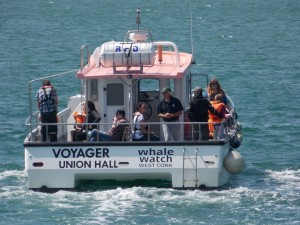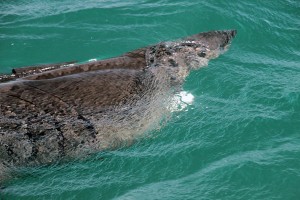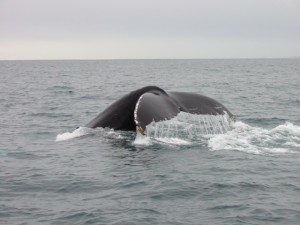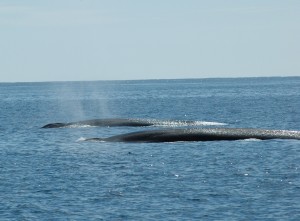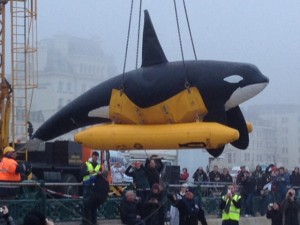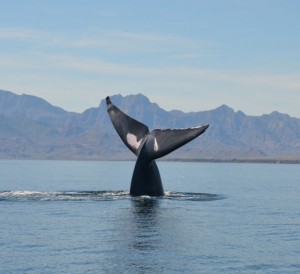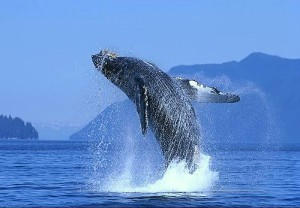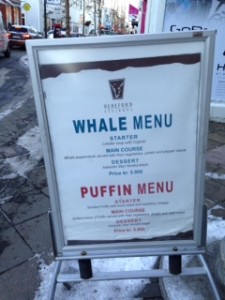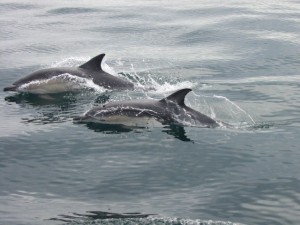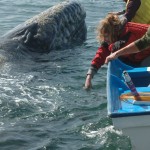I thought my sightings of blue whales off Baja this past February 2014 were insurmountable…but I always forget just how fabulous Spring wildlife sightings are off gorgeous Baltimore and the Islands.
After her routine winter refit and servicing our trusty ship Voyager was back in the water early April and since then we have had some lovely marine wildlife encounters off Baltimore and the Islands, around The Fastnet Rock and Lighthouse, south of The Kedges and well offshore. Sightings have been increasing steadily throughout April in what has been a great month from the weather point of view with bouts of really warm, sunny weather.
On many trip we were able to venture well offshore and had several good encounters with common dolphin groups as they foraged along the coast. Early in the season is not a traditionally the best time to see the short beaked common dolphin as they tend to move inshore towards the end of July affording us gorgeous sightings right through to the end of the year.
With the warm sunny weather the phytoplankton has been drawn up to the surface of the water column and you know what that means…yes, basking sharks. Right on cue the “baskers” turned up off Baltimore and we have recorded an eight metre animal south of the harbour with some nice breaching activity off the islands. Although the window of opportunity is not huge for basking sharks, the second largest fish in the world, we hope to see them through until the beginning of June.
Following a 75% drop in porpoise sightings throughout our operating area during the 2013 season we have started to see this engaging little cetacean more frequently towards the end of April and during early part of May. A group of 10-12 animals feeding in the Gascanane Sound May 2nd was a treat we had not enjoyed for several months. I love this diminutive little animal as they really don’t like people, engines or boats very much and to get good sightings requires all the tenets of responsible boat based cetacean watching, something Whale Watch West Cork champions through their membership of the Responsible Whale Watch Partnership of Whale Watch International.
My colleagues around the coast have been sending in sightings of a variety of marine wildlife but none are so exciting as the first sightings of one of my favourite little baleen whales, the minke whale. Over the last few weeks sightings have been sent in to Whale Watch West Cork with good encounters off Derrynane, the Mizen Head and Cape Clear Island to name a few. All confirmed sightings sent in to me are posted on the Sea Watch Foundation website where you can post directly online. During the past two weeks some excellent minke whale sightings have been recorded from both land and sea off Baltimore and the Islands.
One of the highlights of this past 10 days was the group of 12 Risso’s dolphins we encountered in Baltimore Bay. Feeding with several young animals it is always a delight to see these unusual dolphins with their white colouration (older animals), snub noses and large dorsal fins so reminiscent of a young female killer whale. Lots of spy hopping and tail splashing from the younger, darker skinned members of the group.
For the avid birders among us we are encountering good groups of guillemots, black guillemots, puffins, razorbills, Manx shearwaters, gannets and great northern divers around the islands and offshore Baltimore.
More to come as we get further into the season and regular postings on Facebook and Twitter.
Don’t forget the National Whale and Dolphin Watch 2014 run by the Sea Watch Foundation. For a whole week from 26th July to 3rd August. They are delighted to get any sightings you may have and you can post them directly online through their up-to-date website.
If you are heading down the stunning Wild Atlantic Way this year don’t forget to make a turn down the Golden Spur to Baltimore and the Islands. Sample the local fresh cuisine in family run restaurants and bars. Stay in B&B’s and small hotels offering some of the best value in Ireland and travel to the islands. All this and more available in beautiful Baltimore – the whale watching capital of West Cork.
